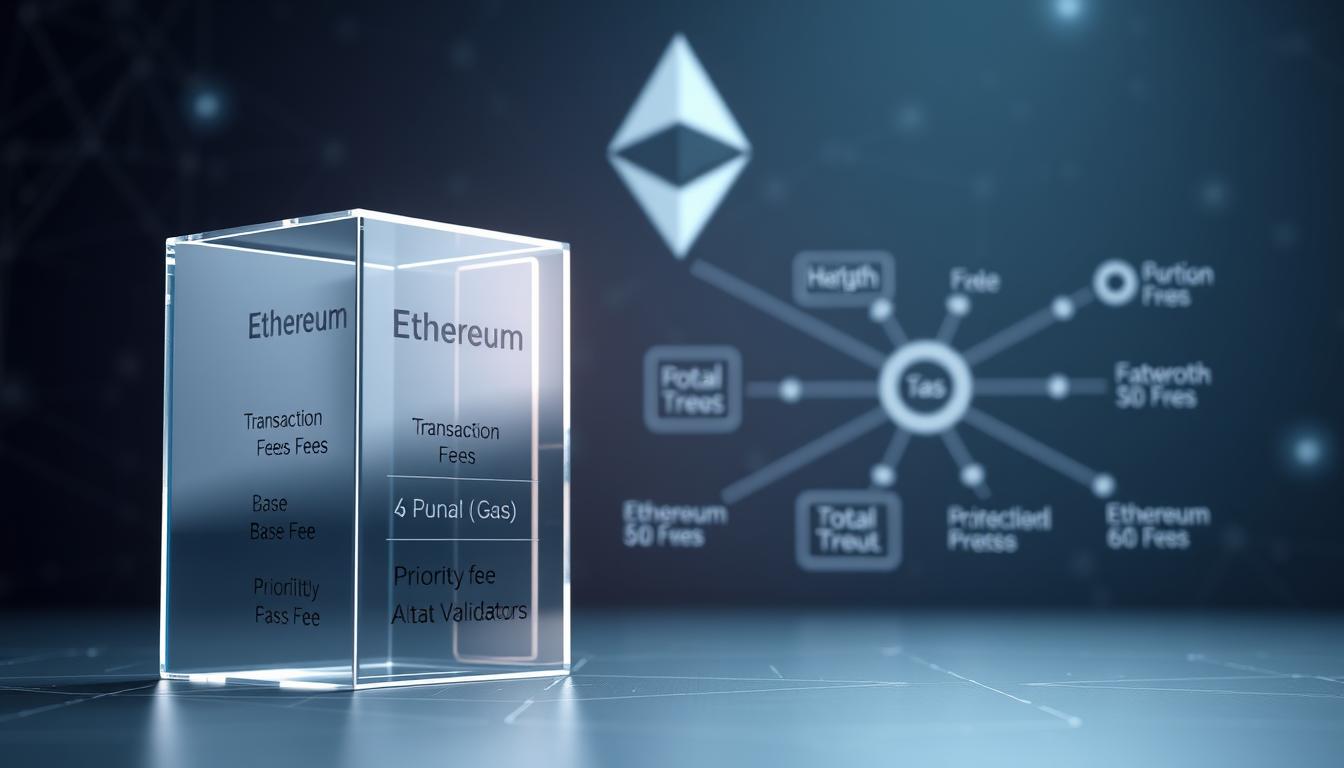Now Reading: Ethereum Gas Fees Explained: Causes and Solutions
- 01
Ethereum Gas Fees Explained: Causes and Solutions
Ethereum Gas Fees Explained: Causes and Solutions


Every action on blockchain networks requires resources, and someone has to pay for them. This is where transaction costs come into play—a critical element that keeps decentralized systems running smoothly. These costs act as both a reward for validators and a security measure, ensuring only legitimate activities get processed.
Prices for these services aren’t fixed. They swing wildly based on how many people are using the network at any moment. During peak times, costs can spike to triple digits, while quieter periods might see prices drop to fractions of a cent. This volatility stems from how blockchains prioritize space and computational power.
Why does this matter? Without financial incentives, few would dedicate hardware and energy to maintain the system. At the same time, attaching a price tag to each action stops bad actors from flooding the network with spam. It’s a delicate balance between accessibility and protection.
Compared to other chains, this model has unique advantages and challenges. Some networks handle transactions faster or cheaper, but Ethereum’s approach emphasizes security and decentralization. As we’ll explore later, tools exist to help navigate these costs effectively without compromising on safety.
Key Takeaways
- Transaction costs reward validators and protect network integrity
- Prices fluctuate based on real-time supply and demand
- ETH serves as the primary currency for these payments
- High traffic directly impacts processing speed and cost
- Alternative networks offer different trade-offs for users
- Timing and tools can significantly reduce expenses
Introduction to Ethereum Gas Fees
Behind every digital interaction on decentralized platforms lies a hidden engine powering its execution. This system ensures operations run smoothly while keeping the network secure and functional. Let’s break down how this mechanism works and why it matters.
What Are Gas Fees?
Think of these costs as fuel for blockchain activities. Every action—whether transferring tokens or interacting with apps—requires computational effort. Validators dedicate hardware and energy to process these tasks, and transaction costs reward their work.
Simple actions like sending funds use minimal resources. Complex tasks, such as executing automated agreements or minting digital assets, demand more power. This tiered structure ensures fair pricing based on actual network demands.
Role of Gas Fees in the Ethereum Network
Beyond compensating validators, these payments act as a security shield. By attaching real value to each operation, the system discourages spam attacks that could clog the network. This balance maintains both accessibility and protection for all users.
Decentralized apps and financial protocols rely on this model to function. Without it, malicious actors could overwhelm the system with fake requests. The result? A self-sustaining ecosystem where every participant contributes to its stability.
Understanding the Basics of Gas Fees on Ethereum
Navigating blockchain interactions requires understanding the fuel that powers them. This system uses precise measurements to balance computational effort with fair compensation for network participants. Let’s unpack the core components driving these costs.

Definition and Key Concepts
Gas units act as the measuring stick for computational work. Each operation—from sending tokens to deploying smart contracts—consumes a specific amount of these units. Complex tasks require more units, reflecting their higher resource demands.
The system uses wei as its base currency unit, but prices typically appear in gwei for practicality. One gwei equals 0.000000001 ETH, making calculations easier than using 18 decimal places. This standardization helps users estimate costs without advanced math skills.
Gas Units, Gas Price, and Gwei Explained
Two factors determine total transaction expenses: the gas units needed for an action and the price per unit set by users. For example, sending ETH might use 21,000 units, while minting NFTs could require 100,000+ units.
When network activity surges, validators prioritize transactions offering higher gwei values. Users can adjust their bids to balance speed and cost-effectiveness. This flexibility allows strategic planning—pay premium rates during urgent transfers or wait for calmer periods.
Understanding these mechanics empowers better decision-making. Tools like real-time trackers display current gwei prices, helping users time their transactions wisely without compromising network security.
How Ethereum Gas Fees are Calculated
Blockchain operations require a precise cost structure to balance user needs with network efficiency. This system uses mathematical formulas and adjustable parameters to determine what you pay for each action.
The Calculation Formula
Total costs follow this equation: (Base Fee + Tip) × Limit = Final Price. Imagine sending funds when the base is 75 gwei. Add a 5 gwei tip and set a 30,000 unit limit. Your total becomes (75+5) × 30,000 = 2.4 million gwei (0.0024 ETH).
This model replaced chaotic bidding wars in 2021 through EIP-1559. The base fee now adjusts automatically every block based on demand. Excess amounts get permanently removed from circulation through burning.
Breaking Down the Components
Base fee acts as the network’s heartbeat. An algorithm sets this minimum price using real-time activity data. When traffic spikes, the cost rises. During lulls, it drops.
Priority fees (tips) let users jump the queue. Higher tips mean faster confirmations. For non-urgent transfers, smaller tips save money. Wallets often suggest optimal amounts based on current conditions.
The limit serves as a safety net. It caps how much resources your action can consume. Standard transfers use 21,000 units, while complex smart contracts might need 100,000+. Setting this too low risks failed transactions. Too high wastes funds.
Factors Influencing Ethereum Gas Fees
The cost of blockchain operations fluctuates based on several key factors. Two primary elements shape these expenses: how busy the network gets and how complicated the actions users perform are. When many people try to use services simultaneously or execute complex tasks, costs naturally rise.

Network Congestion and Demand
Peak activity periods create fierce competition for block space. Historical events like the 2017 token sale boom and 2020’s decentralized finance explosion saw prices multiply rapidly. Users bid aggressively to get their transactions processed first during these surges.
Market volatility often fuels sustained demand. Bull markets trigger more trading and protocol interactions, keeping costs elevated for days. Activity patterns also follow global time zones, with predictable lulls during weekends or off-hours.
Transaction Complexity and Smart Contracts
Simple transfers consume minimal resources—about 21,000 computational units. But automated agreements and digital asset creation require multiple steps, from verifying conditions to updating records. Each operation adds layers of complexity.
Advanced interactions might involve cross-protocol communication or data storage changes. These processes demand 5-10 times more resources than basic transfers. Choosing simpler actions during busy periods helps manage expenses effectively.
When Are ETH Gas Fees Lowest?
Timing shapes blockchain transaction expenses as dramatically as market volatility does. Costs rise and fall in sync with global participation levels, creating predictable windows for budget-conscious interactions. Savvy users leverage these patterns to minimize expenses without sacrificing efficiency.
Identifying Off-Peak Transaction Times
Weekends often deliver the most consistent savings. From Saturday morning to Sunday evening UTC, trading desks slow down and decentralized platforms see lighter usage. This lull stems from reduced institutional activity and fewer automated protocol interactions.
Early morning hours (2-6 AM UTC) frequently offer prime conditions. With Asia-Pacific markets closed and European traders yet to start their day, competition for block space softens. Historical data shows fees during these windows can drop 40-60% compared to peak periods.
Real-time tracking tools transform guesswork into strategy. Platforms like Etherscan’s Gas Tracker display live price trends, while wallet integrations suggest optimal submission moments. Users preparing complex actions—like NFT mints or multi-step swaps—can schedule these during identified low-cost intervals.
Seasonal patterns also play a role. Holiday weekends and market consolidation phases often correlate with sustained price drops. By analyzing historical charts on the Ethereum network, users spot recurring opportunities tied to specific dates or events.
Exploring Layer-2 Solutions and Alternatives
Innovators have developed creative methods to address blockchain scalability challenges while maintaining security standards. These approaches fall into two categories: enhancements built atop existing networks and entirely new platforms with distinct architectures.

Layer-2 Technologies for Cost Reduction
Scaling solutions process multiple operations away from the main network. Optimistic Rollups like Arbitrum bundle hundreds of transactions into single batches. They assume validity unless challenged, drastically cutting verification needs.
Zero-knowledge alternatives like zkSync take a different approach. Cryptographic proofs confirm entire batches without revealing transaction details. This method maintains privacy while slashing costs to pennies per action. Major decentralized apps now support these networks, letting users interact at 95% lower expenses.
Alternative Blockchains with Lower Fees
Newer networks employ different consensus models to achieve efficiency. Solana uses proof-of-history to process thousands of operations per second. Binance Smart Chain combines proof-of-stake with centralized validation checkpoints for rapid confirmations.
Cross-chain bridges simplify asset transfers between ecosystems. Users can mint tokens on low-cost networks and move them when needed. While these platforms offer savings, they involve trade-offs in decentralization or security compared to established systems.
Adoption metrics show growing preference for these options. Over 60% of DeFi activity now occurs through scaling solutions or alternative chains, proving users prioritize affordability without abandoning core blockchain benefits.
ethereum gas fees: Their Impact on Network Security and Efficiency
Blockchain systems rely on carefully designed economic models to stay secure and functional. These frameworks reward participants for honest behavior while making malicious actions financially impractical. Let’s examine how this balance operates in practice.
Validator Incentives and System Protection
The 2022 network upgrade fundamentally changed how participants earn rewards. Validators now receive compensation through transaction costs instead of traditional mining. This shift reduced energy demands by 99.95% while maintaining robust protection against attacks.
Every confirmed operation contributes to two critical goals:
- Compensating those who verify transactions and maintain infrastructure
- Creating financial barriers against spam or network-clogging attempts
Complex smart contracts require more resources than simple transfers, automatically pricing out frivolous requests. Market-driven pricing ensures urgent operations get priority without compromising accessibility. During peak usage, this model naturally filters out low-value actions.
The system’s design prevents artificial inflation of costs through automatic adjustments. Validators remain motivated to keep hardware operational, knowing their efforts directly impact earnings. This symbiotic relationship between users and validators forms the backbone of decentralized security.
Tools and Strategies for Optimizing Gas Fees
Mastering blockchain efficiency starts with smart resource management tools. These solutions help users navigate fluctuating network conditions while maximizing value. By combining real-time data with strategic timing, participants achieve significant cost reductions without compromising transaction reliability.
Real-Time Gas Trackers and Calculators
Platforms like Etherscan’s Gas Tracker provide instant visibility into current network demand. Users see live price charts showing optimal submission windows, often identifying 30-50% savings opportunities. Wallet integrations like MetaMask’s fee estimator automatically suggest competitive bids based on urgency levels.
Advanced tools go beyond basic metrics. ETH Gas Station analyzes historical patterns to predict future trends, while decentralized apps offer fee customization sliders. Setting alerts for specific price thresholds lets users act swiftly when conditions improve.
Combining these resources creates a powerful strategy. Check trackers during off-peak hours (weekends or late-night UTC), then use calculators to set precise limits. This approach balances speed and affordability, especially for complex smart contract interactions.
FAQ
Why do transaction costs vary so much on Ethereum?
Costs depend on block space demand and network activity. When many users send transactions or interact with smart contracts, validators prioritize higher-paying requests, driving up prices. Tools like Etherscan’s Gas Tracker help monitor real-time trends.
How does the base fee differ from a tip?
The base fee is set by the protocol and adjusts per block based on congestion. A tip (priority fee) is an extra amount paid to speed up confirmation. Both are measured in Gwei, a fraction of ETH.
Can complex actions like NFT minting increase costs?
Yes. Operations requiring more computational power, such as deploying contracts or minting NFTs, consume higher gas limits. This raises total fees since users pay for each unit of computational effort.
What strategies reduce expenses during peak hours?
Scheduling transactions during off-peak times (late nights or weekends) often lowers prices. Platforms like Uniswap or OpenSea also integrate layer-2 solutions like Optimism to bypass mainnet congestion.
Are alternative blockchains truly cheaper than Ethereum?
Chains like Solana or Avalanche offer lower per-transaction costs by optimizing consensus mechanisms. However, Ethereum’s security and decentralized ecosystem often justify its premium for high-value transactions.
How do fees contribute to network security?
Validators earn fees for processing transactions, incentivizing them to maintain hardware and honest behavior. This system discourages spam attacks, as malicious actors would face steep costs.
What tools help estimate optimal gas prices?
Trackers like GasNow and ETH Gas.Watch provide live updates. Wallets such as MetaMask also suggest customized settings based on current network conditions.
Why do some wallets allow adjusting gas limits?
Users can set higher limits for complex actions to avoid failed transactions. However, exceeding necessary limits wastes funds, so platforms like MyEtherWallet recommend default values for most cases.
Does the transition to proof-of-stake affect pricing?
Ethereum’s upgrades aim to improve scalability, potentially reducing congestion. Solutions like sharding and rollups further distribute load, which could stabilize long-term costs.















